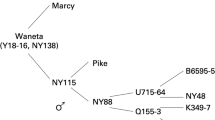Conclusions
Leaf roll and spindle tuber virus infected tubers can be processed into potato chips as light and uniform in color as those of apparently healthy controls. Tubers from hills showing vine symptoms of mosaic and calico virus also made equally light colored chips as the checks. Haywire and giant hill infected plants can be expected to produce tubers that will chip much darker in color. In addition it has been observed that any condition which results in necrosis of tuber tissue will also produce dark chips.
Blackleg infected tubers produce chips with dark edges while Fusarium infection and the resulting discoloration causes a dark brown ring or portion of a ring in the chip.
Similar content being viewed by others
Literature Cited
Jones, E. D. 1955. Correlation of field disease diagnosis with the performance of infected tubers in potato chip manufacture. Proc of the P. & T. Division Meetings of the National Potato Chip Inst.
Author information
Authors and Affiliations
Additional information
Approved by the Director as Scientific Series article No. 644.
Rights and permissions
About this article
Cite this article
Chapman, H.W., Frutchey, C.W. Effects of viruses and other potato diseases on chip color. American Potato Journal 37, 257–259 (1960). https://doi.org/10.1007/BF02855799
Accepted:
Issue Date:
DOI: https://doi.org/10.1007/BF02855799




